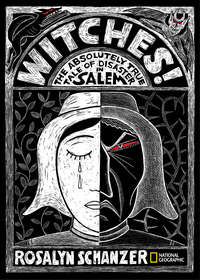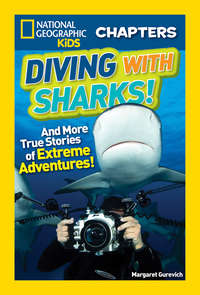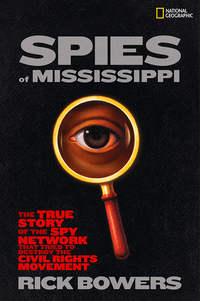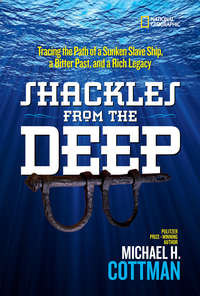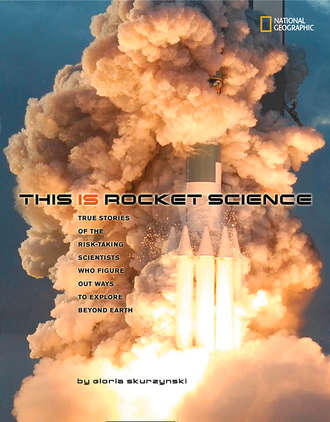
Полная версия
This Is Rocket Science: True Stories of the Risk-taking Scientists who Figure Out Ways to Explore Beyond

THIS IS ROCKET SCIENCE
TRUE STORIES OF THE RISK-TAKING SCIENTISTS WHO FIGURE OUT WAYS TO EXPLORE BEYOND EARTH
by Gloria Skurzynski

FOR MEGAN ALANE GLORIA LEDESMA, WHO WILL LIVE IN A WHOLE NEW WORLD—GS
PUBLISHED BY THE NATIONAL GEOGRAPHIC SOCIETY
John M. Fahey, Jr.,
President & Chief Executive Officer
Gilbert M. Grosvenor,
Chairman of the Board
Tim T. Kelly,
President, Global Media Group
John Q. Griffin,
Executive Vice President; President, Publishing
Nina D. Hoffman,
Executive Vice President; President, Book Publishing Group
Melina Gerosa Bellows,
Executive Vice President, Children’s Publishing
PREPARED BY THE BOOK DIVISION
Nancy Laties Feresten,
Vice President, Editor in Chief, Children’s Books
Jonathan Halling,
Design Director, Children’s Publishing
Jennifer Emmett,
Executive Editor, Reference & Solo Titles, Children’s Books
Carl Mehler,
Director of Maps
R. Gary Colbert,
Production Director
Jennifer A. Thornton,
Managing Editor
STAFF FOR THIS BOOK
Suzanne Fonda,
Project Editor
David M. Seager,
Art Director
Lori Epstein, Gloria Skurzynski,
Illustrations Editors
Priyanka Lamichhane,
Associate Editor
Grace Hill,
Associate Managing Editor
Lewis R. Bassford,
Production Manager
Susan Borke,
Legal and Business Affairs
Manufacturing and Quality Management
Christopher A. Liedel,
Chief Financial Officer
Phillip L. Schlosser,
Vice President
Chris Brown,
Technical Director
Nicole Elliott, Rachel Faulise,
Managers
ACKNOWLEDGMENTS
The author is exceedingly grateful to rocket scientist Ed Skurzynski and to dedicated editor Suzanne Patrick Fonda and art director David Seager for their continuous support. Deep thanks also to Françoise Ulam; to David S. Nolan; Marc Rayman at NASA Jet Propulsion Laboratory; Mike Wright and Betty Humphery at NASA Marshall Space Flight Center; Norman Chaffee, Roger Weiss, and Mike Gentry at NASA Johnson Space Center; Gwen Pitman at NASA Media Services; Linda S. Sandoval at Los Alamos National Laboratory; Suzanne DuBeau Rostek at Astrotech Space Operations, Inc; Valerie-Anne Lutz van Ammers at the American Philosophical Society Library; Andrew Ilin at Ad Astra; Roger G. Gilbertson at SpaceX; Jordin Kare at Laser-Motive; and, for her continuing inspiration to students, to France Anne Cordova, President of Purdue University and former NASA Chief Scientist, the youngest person and first woman to hold that position.

The National Geographic Society is one of the world’s largest nonprofit scientific and educational organizations. Founded in 1888 to “increase and diffuse geographic knowledge,” the Society works to inspire people to care about the planet. It reaches more than 325 million people worldwide each month through its official journal, National Geographic, and other magazines; National Geographic Channel; television documentaries; music; radio; films; books; DVDs; maps; exhibitions; school publishing programs; interactive media; and merchandise. National Geographic has funded more than 9,000 scientific research, conservation and exploration projects and supports an education program combating geographic illiteracy. For more information, visit nationalgeographic.com.
For more information, please call 1-800-NGS LINE (647-5463) or write to the following address:
National Geographic Society
1145 17th Street N.W.
Washington, D.C. 20036-4688 U.S.A.
Visit us online at www.nationalgeographic.com/books
For librarians and teachers: www.ngchildrensbooks.org
More for kids from National Geographic: kids.nationalgeographic.com
For rights or permissions inquiries, please contact National Geographic Books Subsidiary Rights: ngbookrights@ngs.org
Copyright © 2010 Gloria Skurzynski. All rights reserved. Reproduction of the whole or any part of the contents without written permission from the publisher is prohibited.
Skurzynski, Gloria.
This is rocket science: true stories of the risk-taking scientists who figure out ways to explore beyond Earth / by Gloria Skurzynski.
p. cm.
Includes bibliographical references and index.
ISBN: 978-1-4263-0717-1
1. Rocketry—Biography. 2. Aerospace engineers—Biography—Juvenile literature. 3. Rocketry—History—Juvenile literature. 4. Rockets (Aeronautics)—History—Juvenile literature. I. Title.
TL781.85.A1S58 2010
629.4092’2—dc22
2009020386
Version: 2017-07-05
CONTENTS
FIRE ARROWS
THE FATHERS OF MODERN ROCKETRY
BEEPS FROM SPACE
SATURN WINS, ORION LOSES
RETURN AND REUSE
SUCCESS AND FAILURE
WAY TO GO
FARTHER NEEDS FASTER
GLOSSARY
BOOKS AND WEB SITES
QUOTE SOURCES AND ILLUSTRATION CREDITS
INDEX
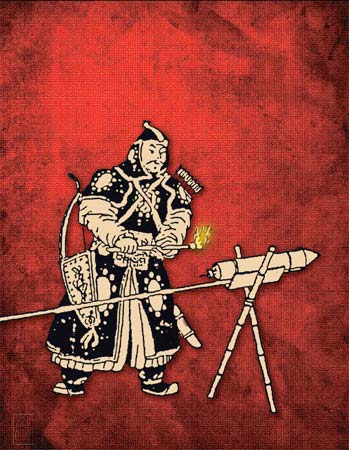
IN THE 13TH CENTURY THE CHINESE DESIGNED FIRE ARROWS TO USE AS WEAPONS AGAINST INVADING MONGOL ARMIES.
1
FIRE ARROWS
Some inventions happen by accident. Two thousand years ago, Chinese scientists searched for a way to make people immortal. They mixed chemicals with liquids and drank them, hoping this would keep them alive forever. Instead, they often died quickly because their experiments contained poisons.
One of the main ingredients in those potions was saltpeter, a potassium nitrate compound found in dry caves in southern China. Alchemists (the scientists searching for eternal life) used saltpeter to dissolve ores and minerals. They learned how to make pure sulfur by heating iron pyrite, also known as fool’s gold. And they could easily obtain carbon from coal or charcoal. During centuries of experimentation, the alchemists discovered that if saltpeter, sulfur, and carbon were combined, the mixture would burn.
By A.D. 1040 a Chinese official described three combinations of these ingredients to make three different kinds of weapons: a poison-smoke ball, a bomb that burned, and a bomb that exploded—but not violently. Later experiments showed that when extra saltpeter was added to the three main ingredients, the combination exploded with greater force. This became the earliest form of gunpowder, named huo yao, meaning “flaming medicine.”
Hollow bamboo tubes filled with this early kind of gunpowder exploded spectacularly when thrown into a fire.
These were the first fireworks. Chinese experimenters attached arrows to these tubes, sealed the tubes at one end, and left the tubes open at the other end. When the gunpowder was lit, a mixture of fire, smoke, and gas flew out through the open end and propelled the weapon forward. Called fire arrows, these weapons weren’t accurate enough to hit their targets very often, but their loud explosions frightened enemies. Chinese crossbowmen could shoot the arrows as far as 650 feet.
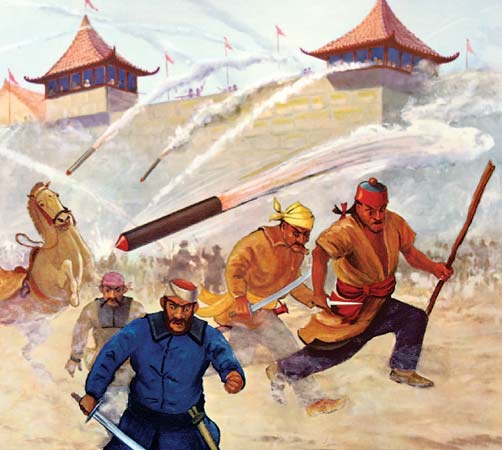
AT FIRST, FIRE ARROWS FRIGHTENED MONGOL INVADERS AND TERRIFIED THEIR HORSES. THEN THE SOLDIERS LEARNED TO USE FIRE ARROWS AGAINST THEIR OWN ENEMIES.
To the north of China lived nomadic tribes that moved their herds over vast distances of unbroken deserts and grasslands. Many of these tribes united to form the Mongol Empire under the command of the famous Genghis Khan. In A.D. 1232 an army of 30,000 Mongol warriors invaded the Chinese city of Kai-fung-fu, where the Chinese fought back with fire arrows. A book about this battle describes the destruction caused by a single fire arrow: “When it was lit, it made a noise that resembled thunder and extended [about 15 miles]. The place where it fell was burned, and the fire reached more than 2000 feet…. These iron nozzles, the flying powder halberds that were hurled, were what the Mongols feared most.” The explosions especially terrified the horses. Mongol leaders learned from their enemies and found ways to make fire arrows even more deadly as their invasion spread toward Europe.

CHINESE CHARACTERS FOR “ROCKET” AND “FIRE ARROW”
On Christmas Day 1241 Mongol troops used fire arrows to capture the city of Budapest in Hungary, and in 1258 to capture the city of Baghdad in what’s now Iraq. Soon the Arabs in Baghdad created their own fire arrows and used them against the army of French king Louis IX.
By 1300 these weapons had moved farther into Europe, reaching Italy by 1500. There, the people enjoyed exploding them for the same reason the Chinese had at first: to make fireworks. In the old Italian language rocce was the word for a long, thin tube. As fire arrows advanced into explosive devices using tubes of iron filled with gunpowder, the word “rocce” evolved into the word “rocket.”
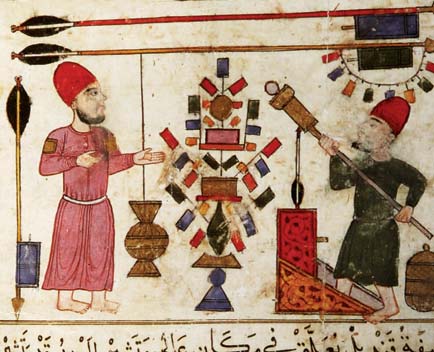
AS THE MONGOL CONQUERORS MOVED WEST INTO THE ARAB WORLD, PEOPLE THERE LEARNED TO MAKE THEIR OWN FIRE ARROWS.
Nearly two centuries after the Italians coined the term that became the English word “rocket,” British scientist Sir Isaac Newton formulated his famous laws of gravity and motion, now frequently used to explain how rockets and propulsion work. This statue (left) shows Newton standing above an apple. Tradition says that seeing an apple fall from a tree inspired his thoughts about gravity. Newton also built on the ideas of scientists who had come before him—Copernicus, Galileo, and Kepler—to formulate the three laws of motion. He published them in 1687 in a book titled Philosophiæ Naturalis Principia Mathematica (Mathematical Principles of Natural Philosophy).

WHEN HE SAW AN APPLE FALL FROM A TREE, ISAAC NEWTON BEGAN TO STUDY GRAVITY.
Newton’s first law states, “Every object persists in its state of rest or uniform motion in a straight line unless it is compelled to change that state by forces acting upon it.” In other words, if something isn’t moving, it will stay where it is until something moves it. And if it’s moving, it will keep moving at the same speed and in the same direction unless a force acts upon it to change its speed or direction.
What are the forces in Newton’s first law as it applies to rockets? Gravity is a force. From the first millisecond of launch, Earth’s gravity pulls on the rocket. The force of gravity between two objects depends on the masses of the two objects and the distance between the centers of mass of the two objects. As the distance between two objects gets larger—for example, the distance between Earth and a moving rocket—the gravitational force between them gets smaller.
Thrust is a force caused by hot gases coming out of the rocket that are counteracting the force of gravity and pushing upward against another force: air resistance. These three forces work together, acting on the rocket at launch and during flight.
Newton’s second law says, “Force equals mass multiplied by acceleration.” As one rocket scientist says, “It’s a ridiculously simple and at the same time complex equation.” Mass is the amount of matter in an object. Weight is the gravitational attraction of the mass, and the weight stays constant unless the force of gravity is changing. Acceleration is the rate of change in the velocity (speed) of a moving body—a measure of how fast the object is changing its speed.
Thrust in a rocket depends on the rate at which the mass of the burning fuel inside the rocket is expelled through the nozzle at the end of the rocket and the speed at which it escapes. The force of the extremely hot gases escaping through the nozzle accelerates the rocket. The heavier the rocket, the more thrust/force will be needed to move it. If a rocket weighs a million pounds and only a million pounds of thrust is produced, the rocket won’t move. To launch it off the ground requires a thrust greater than a million pounds so it can overcome gravity and air resistance. To increase the thrust level requires burning more fuel, using a higher-energy fuel, or both.
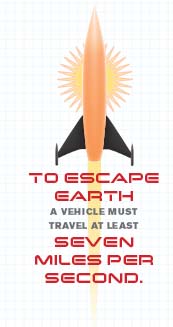
Newton’s third law reads, “For every action there is an equal and opposite reaction.” With rockets, the action is the expelling of high-speed exhaust through the back end. The reaction is the movement of the rocket in the opposite direction. The same thing happens when you blow up a balloon and let it go. The air rushing out of the open end shoots the balloon away from you.
After Newton published his laws of motion, people began to think of rocketry as a science, which of course it had been all along. In the 1700s Germans and Russians experimented with rockets so powerful that, when lit and fired, their blasts blew holes in the ground. Gradually, as they understood and applied Newton’s laws of motion, scientists began to understand the forces in rocketry—how to control them and what to expect.
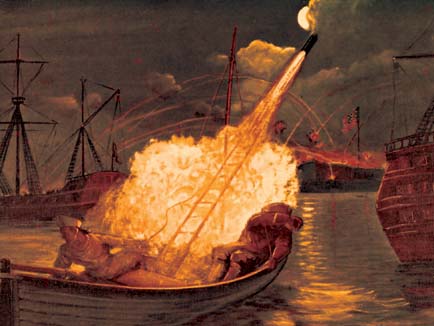
DURING THE WAR OF 1812, AS BRITISH WARSHIPS FIRED ROCKETS ON FORT MCHENRY IN MARYLAND FRANCIS SCOTT KEY WROTE ABOUT “THE ROCKETS’ RED GLARE.”
Just before the beginning of the 20th century, black
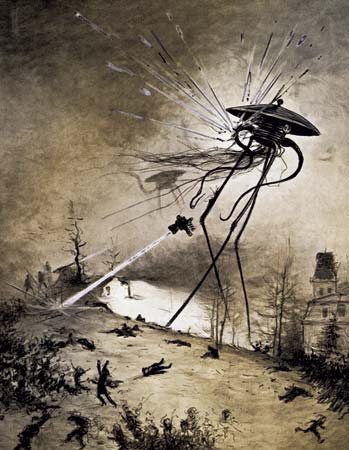
H. G. WELLS’S NOVEL THE WAR OF THE WORLDS INSPIRED YOUNG FUTURE SCIENTISTS TO DREAM OF SPACE TRAVEL.
2
THE FATHERS OF MODERN ROCKETRY
Born in 1857, Konstantin Tsiolkovsky was one of 18 children of a Polish patriot who’d been deported to Russia. When Konstantin was ten years old, he became deaf from scarlet fever. This kept him out of school, but he taught himself by studying as many books as he could borrow, including From the Earth to the Moon, the science-based imaginative space-travel adventure by French author Jules Verne. This novel was published at about the time young Konstantin learned to read.
Impressed by his enthusiasm for learning, Konstantin’s family sent him to Moscow when he was 16. There, a teacher, who also recognized the boy’s brilliance, tutored him at a library every day for three years. Tsiolkovsky not only studied mathematics and science but also became intrigued by rockets.
Later he recalled, “For a long time I thought of the rocket as everybody else did—just as a means of diversion and of petty everyday uses. I do not remember exactly what prompted me to make calculations of its motions. Probably the first seeds of the idea were sown by that great fantastic author Jules Verne—he directed my thought along certain channels, then came a desire, and after that, the work.” As early as 1865, when From the Earth to the Moon was published, Jules Verne already knew that escaping Earth’s gravity would require great speed. Tsiolkovsky began to think of ways to go fast enough to leave Earth behind. “Earth is the cradle of humanity,” he said, “but humanity cannot remain in the cradle forever.”
At the age of 21 Tsiolkovsky took a job as a math teacher in a small town south of Moscow, where he began to develop his ideas about space flight—not only how to blast rockets off the ground, but also how they could carry humans into space. He wrote scientific articles and several decades later published one titled “The Exploration of Cosmic Space by Means of Reaction Devices.” It encouraged readers to “[v]isualize…an elongated metal chamber…designed to protect not only the various physical instruments but also a human pilot…. The chamber is partly occupied by a large store of substances which, on being mixed, immediately form an explosive mass.”
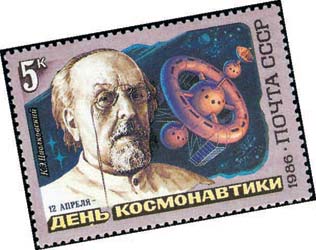
KONSTANTIN TSIOLKOVSKY
Tsiolkovsky knew that the speed at which gas escapes from a rocket—called its exhaust velocity—results from the explosive force of the rocket fuel. The more powerful the explosion, the greater the thrust. The propellant mixture Tsiolkovsky had in mind was liquid oxygen (LOX) combined with liquid hydrogen (LH2), since LH2 provides high energy per pound.
Halfway around the world, just four years before Tsiolkovsky published his “Reaction Devices” article, 17-year-old Robert Hutchings Goddard climbed a cherry tree behind the barn of his Massachusetts home. A year earlier, in 1898, Goddard had read H. G. Wells’s science fiction novel The War of the Worlds. Perhaps its scenes about invaders from Mars lingered in his mind, because he later wrote that on that day, “I imagined how wonderful it would be to make some device which had even the possibility of ascending to Mars, and how it would look…if sent up from the meadow at my feet….”
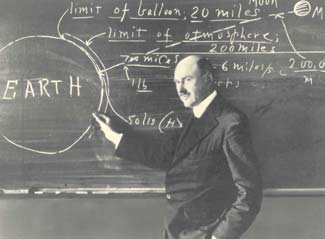
ROBERT GODDARD BELIEVED THAT LIQUID-FUEL ROCKETS COULD FLY AS FAR AS THE MOON.
At Clark University Robert Goddard received a Ph.D. in physics and set up an experiment to prove that rockets could fly in a vacuum, which most people doubted. He built a chamber, removed all the air from it, put a small rocket inside, and fired it. This experiment convinced him that rockets could not only fly in a vacuum, but also achieve up to 20 percent more thrust in a vacuum than in air because there was no air resistance to reduce the rocket’s thrust.
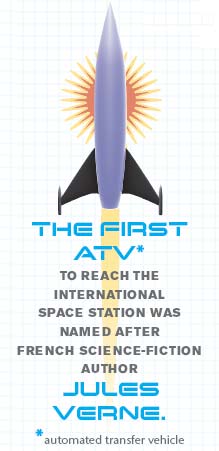
Goddard had ideas about fuel, too. Unaware of Tsiolkovsky’s article, Goddard believed that liquid propellant was a higher-energy fuel that created more thrust than solid propellant did. In solid-fuel rockets the grain (the propellant charge) is densely packed and molded inside a casing. Goddard understood the disadvantages of liquid propellants—they’re harder to handle than solid propellants like gunpowder. Also, the two components, fuel and oxidizer, have to be kept in separate tanks until launch, and liquid oxygen (the oxidizer) must be stored at a very low temperature, near –300°F. But the advantage of liquid propellants is that during flight, the rate at which they’re injected into the combustion chamber can be increased or decreased or shut off if necessary, while solid fuels burn until they’re completely used up. Goddard would have liked to combine LH2 with LOX, but LH2 was hard to come by. Instead, he used gasoline combined with LOX for his rocket experiments.
“PROFESSOR GODDARD…SEEMS TO LACK THE KNOWLEDGE LADLED OUT DAILY IN HIGH SCHOOLS.”
NEW YORK TIMES
In 1920 Goddard published a paper titled “A Method for Reaching Extreme Altitudes.” It claimed that if a rocket was large enough and had fuel that was powerful enough, it could reach the Moon. The press ignores most academic papers, but the New York Times happened to see this one and responded by ridiculing Dr. Goddard’s theory about flights in a vacuum. The Times insisted that space travel was impossible because unless a rocket had an atmosphere to push against, it couldn’t move at all: “That Professor Goddard…does not know the relation of action to reaction, and of the need to have something better than a vacuum against which to react—to say that [about reaching the Moon] would be absurd. [He] seems to lack the knowledge ladled out daily in high schools.” It didn’t matter that the New York Times was wrong and Goddard was right; Goddard felt humiliated. He moved to New Mexico and continued his rocket research away from the public eye.
Across the Atlantic a young German tried to recover from his country’s defeat in World War I. Like Tsiolkovsky, Hermann Oberth had been fascinated as a boy by Jules Verne’s novel From the Earth to the Moon. He said later that he’d read it “at least five or six times and, finally, knew [it] by heart.” Oberth realized that some of Verne’s ideas were not just science fiction, but real science. At age 14 Oberth designed a model rocket. He had no way to test it, but he delved into mathematics to teach himself propulsion theories.
After the war Oberth studied physics. In 1923 he wrote a paper called “By Rocket into Planetary Space,” and in 1929, in a longer version of the paper, he forecast “rockets…so [powerful] that they could be capable of carrying a man aloft.” In a footnote Oberth mentioned Goddard’s “A Method for Reaching Extreme Altitudes.”
Russia not only had lived through World War I but also had survived a turbulent revolution that increased its territory and gave rise to a new name: Union of Soviet Socialist Republics, or Soviet Union for short. When the Soviet newspaper Izvestia mentioned Oberth’s publication, Tsiolkovsky read it and saw the reference to Goddard’s work, which he hadn’t heard about. Tsiolkovsky decided to republish his own early articles about space travel and include with them a number of his newer theories.
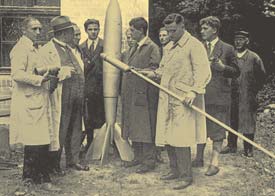
PROFESSOR HERMANN OBERTH, (TO THE RIGHT OF THE LARGE ROCKET), GATHERS MEMBERS OF HIS DESIGN TEAM FOR A TEST FIRING. STUDENT WERNHER VON BRAUN IS SECOND FROM RIGHT.
These three scientists have been called the Fathers of Modern Rocketry. They never met and at first were unaware of each others’ ideas about rocket propulsion, yet they independently came to pretty much the same conclusions. All believed in the superiority of liquid fuels for rocket propulsion. Their research on liquid propellants inspired two men who would become key players in the 1950s space race between two superpowers.
Not long after Oberth wrote his “Planetary Space” paper, 13-year-old Wernher von Braun tied six skyrockets to a toy wagon and lit them. Belching smoke and flame, the little red wagon roared five blocks through a crowded Berlin street and then exploded. In the uproar that followed, police grabbed the boy and kept him in the police station until his furious father came to get him out.
His father’s anger didn’t put an end to von Braun’s fascination with rockets. Like so many other budding rocket scientists, he’d read the science fiction of Jules Verne and H. G. Wells. But he’d also read Oberth’s paper, which inspired him to learn calculus and trigonometry so he could understand the physics of rocketry. Later, as von Braun studied for his Ph.D. at the University of Berlin, he worked as an assistant to Professor Oberth, and in 1932 von Braun and a few other men began designing liquid-fuel rockets for the German military.




